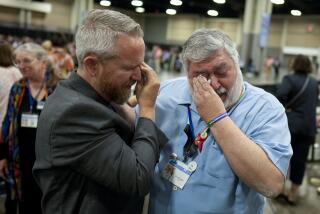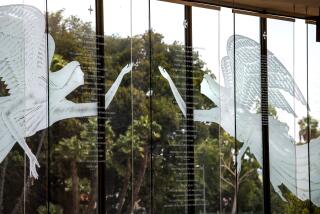‘I Think We Made History!’
- Share via
Lutherans and Episcopalians united in a church service Sunday morning in Seal Beach, marking a historic and symbolic joining of two denominations.
A joint service also was held in San Marino in honor of the unity agreement titled “Called to Common Mission,” which will be formally signed Saturday at the Washington National Cathedral. The pact, between the Episcopal Church and the Evangelical Lutheran Church in America, allows members of the two denominations to receive communion in each other’s churches and call either an Episcopal priest or a Lutheran minister their pastor.
In the Seal Beach service, the Rt. Rev. J. Jon Bruno, bishop coadjutor of the Los Angeles Episcopal Diocese, called Sunday the “beginning of a new era.” The service gathered members of two Seal Beach churches: St. Theodore of Canterbury Episcopal Church and Redeemer Evangelical Lutheran Church. The service was held at Redeemer, in Leisure World.
“I never thought I would see this happen,” Bruno said.
In a symbolic gesture, Bruno and Bishop Murray Finck of the Lutheran Church’s Yorba Linda-based Pacifica Synod each signed the agreement during the service. When they were done, the men hugged, the congregations applauded and Bruno announced, “I think we made history!”
He told the congregations that the agreement is more than two denominations setting aside differences to stand together.
“It’s being part of one another,” Bruno said. “We have ways in which to join that make us stronger.”
Approved by Lutheran leaders in 1999 and Episcopal leaders last summer, the agreement forges an alliance recognizing that both denominations have more in common than not. Both emerged from the 16th century Reformation with a shared basic theology but different traditions, rooted in Lutheran origins in Germany and Episcopal origins in England.
Under the agreement, the two denominations retain their separate identities and structures. Most local congregations will not notice a big change, but some members said they hope to see more joint services. Evangelical Lutherans and Episcopalians have been allowed to receive communion in each other’s churches since 1981 under an interim agreement. Now, that agreement is permanent.
Mary Mizer, 54, of Huntington Beach was a delegate to the Episcopal Church’s triennial General Convention. She was among those voting for the union at the July meeting in Denver.
“I wouldn’t have missed this for the world,” said Mizer, who attends St. Wilfrid of York Episcopal Church in Huntington Beach.
“When it actually happened, it was an emotional sense of history. I was privileged to be a part of it, as I am to be here today. The more people who join hands, the more of God’s work we can do. This is a wonderful thing.”
At the San Marino service, the Rt. Rev. Frederick H. Borsch, bishop of the six-county Episcopal Diocese of Los Angeles, looked out over the standing-room-only crowd and thanked choir members from Trinity Evangelical Lutheran Church in San Gabriel for wearing red. Otherwise, he said, “It’s very difficult to tell who’s a Lutheran and who’s an Episcopalian.”
In a sermon, he cited the observations of a theologian that different denominations sometimes took shape to meet social and ethnic needs. Then they had “to establish theological differences to explain the differences between them.”
The unity agreement, between the largest of the U.S. Lutheran denominations with a membership of 5.2 million, and 2.4 million Episcopalians, allows both churches to maintain their own traditions, he said.
“But at a deeper level, we have come together today to establish that we are one church. . . . This is the one word of God that has been given to us.”
Many said they hope this pact is the beginning of a new effort by churches to minimize their disagreements.
“In the past 500 years, we have a much more obvious history of separation and splitting,” Finck said in the Seal Beach service. “It really is a turning moment in the history of God’s people.”
Betty Hobbs, 79, of Leisure World said she has been waiting for this day.
“It’s something we’ve looked forward to,” said Hobbs, an Episcopalian. “There’s similarity of ritual and liturgy and, when you get right down to it, we’re all going to the same place, we hope.”
Father Rafael Luevano of the Roman Catholic Diocese of Orange said he hopes that one day his church will be among the united denominations.
“I think it will happen,” Luevano said. “No matter what our differences are that separate us, we have more in common--the common belief in Jesus Christ.”
*
Staff writer Ted Rohrlich contributed to this report.
More to Read
Sign up for Essential California
The most important California stories and recommendations in your inbox every morning.
You may occasionally receive promotional content from the Los Angeles Times.














